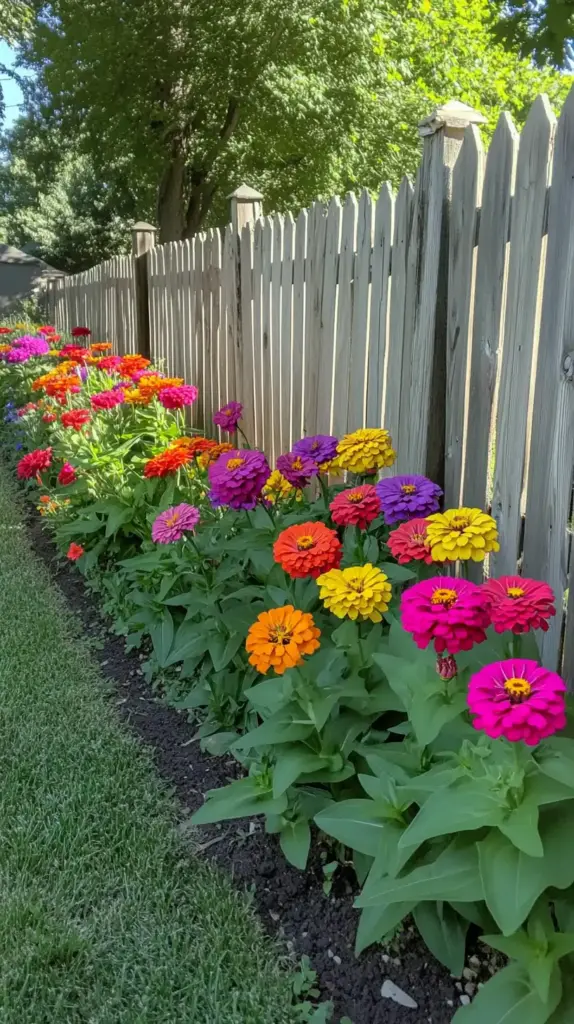If your fence line is looking a little dull, it might be time to transform it into something spectacular. One of the easiest—and most colorful—ways to breathe new life into your landscape is by planting zinnias. These vibrant, low-maintenance flowers come in nearly every shade of the rainbow and bloom for weeks, making them ideal for adding cheer and charm to your yard.
Whether you’re new to gardening or simply seeking fresh inspiration, these zinnia fence line garden ideas will help you craft a space that feels both welcoming and full of life. You can even pair your zinnias with drought-tolerant companions or enhance their impact with DIY garden trellis accents for vertical flair.
Let’s explore some creative, practical ways to bring your fence line to life using zinnias as your stars.
Table of Contents
10 Creative Zinnia Fence Line Garden Ideas for a Cozy Yard
1. Rainbow Gradient Fence Display 🌈
One of the most eye-catching ways to showcase zinnias is with a rainbow gradient planting scheme. Instead of scattering colors randomly, this method arranges the flowers by hue to create a seamless flow from one shade to the next.
🌸 How to Plan Your Gradient
Start by selecting zinnia varieties in red, orange, yellow, green (lime), blue, and purple tones. Arrange them from left to right along the fence to form a natural spectrum. Popular options like California Giant and Benary’s Giant are perfect choices for this style, thanks to their broad color range and tall blooms.
📏 Layer by Height for Visual Impact
Position the tallest varieties (like Oklahoma Series) directly along the fence for a lush backdrop. In front of them, plant medium-height zinnias, and line the very front with compact types like Thumbelina. This tiered approach ensures every flower gets its moment to shine while also maximizing space.
🎨 Transition with Blended Colors
To avoid harsh shifts between colors, use transitional tones:
- Between red and orange: Try salmon or coral zinnias
- Between orange and yellow: Soft apricots or cream-orange shades
- Between yellow and green: Lime zinnias bridge the gap beautifully
- Between green and blue: White or pale green works as a neutral break
- Between blue and purple: Use lavender or violet hybrids
These smooth transitions give your garden a polished, designer look without much extra effort.
✂️ Maintenance Tip
Deadhead spent blooms regularly—about every other day—to keep your rainbow display vibrant and full. Zinnias are prolific bloomers, and this small habit will reward you with even more color over time.
2. Cottage Garden Mix with Zinnias 🌿🏡
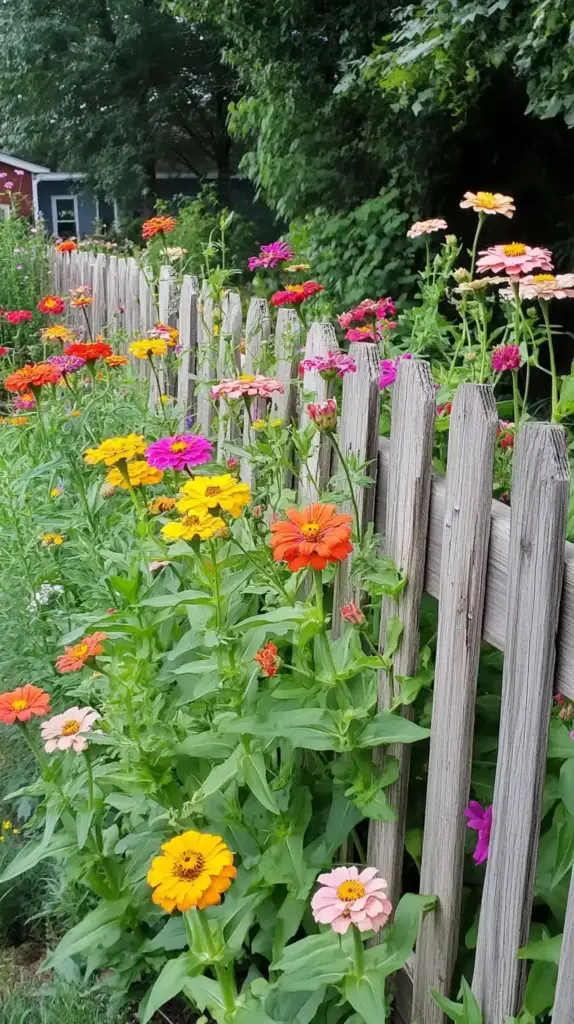
If you’ve ever dreamed of stepping into a storybook garden, this idea is for you. Combining zinnias with traditional cottage flowers along your fence creates a nostalgic, romantic look that feels both natural and curated. This approach celebrates texture, color variety, and a bit of whimsical overgrowth—ideal for gardeners who love a relaxed yet vibrant aesthetic.
🌼 Perfect Flower Pairings
Zinnias mix beautifully with many cottage garden staples. Try these combinations along your fence:
- Zinnias + Cosmos: Airy cosmos soften the structure of zinnias with their delicate petals
- Zinnias + Snapdragons: Adds height and vertical interest
- Zinnias + Salvia or Bee Balm: Bring pollinators and a pop of contrasting form
- Zinnias + Daisies: Simple, classic harmony for a cheerful vibe
Choose 2–3 complementary species to avoid overcrowding, and arrange in drifts for a more natural look.
🏡 Layout Tips for the Cottage Feel
Plant in layers, but let some randomness occur—it’s part of the charm. Place zinnias toward the middle row, with shorter plants like alyssum or creeping thyme in the front, and taller blooms like larkspur or delphinium along the fence. Don’t be afraid to let some plants lean or mingle; this “imperfect” style adds authenticity.
🐝 Why It Works
Not only does this combo create a soft, colorful border, but it also attracts bees, butterflies, and hummingbirds—bringing even more life to your yard. Zinnias are especially beloved by pollinators, and when mixed with other nectar-rich flowers, your fence becomes an ecological hub.
🛠️ Pro Tip: Vary Your Bloom Times
Mix early-, mid-, and late-season bloomers to extend the life of your cottage garden. This ensures you’ve always got something blooming from spring through fall—zinnias being the hardworking anchor of the whole setup.
3. Creating a Butterfly Paradise Border 🦋🌼
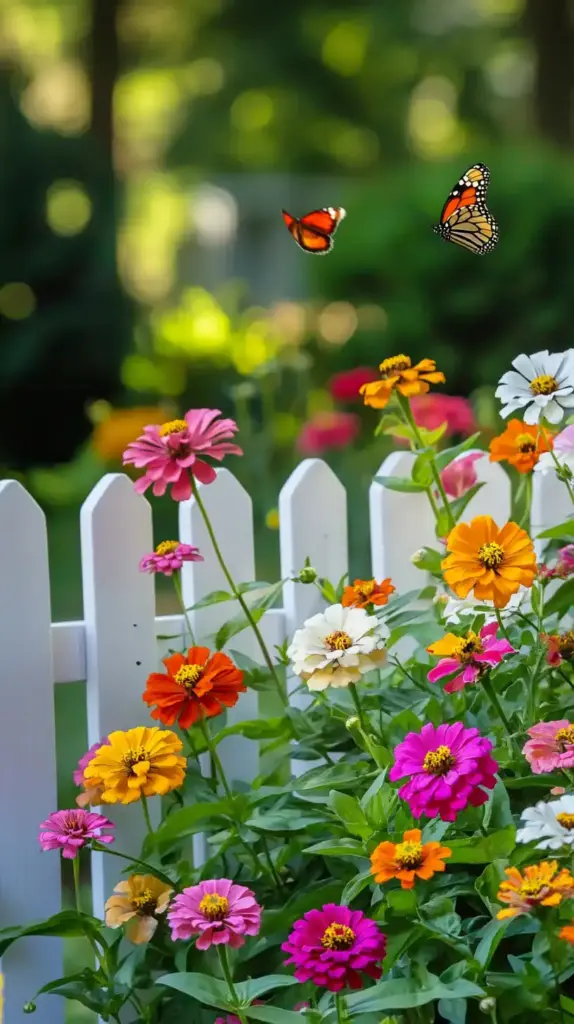
Few things bring a garden to life like the flutter of butterfly wings—and zinnias are one of the best flowers to attract them. With the right setup along your fence, you can create a lively and colorful zinnia fence line garden idea that doubles as a butterfly sanctuary. This design combines smart planting with nature-friendly touches that invite pollinators to linger.
🌿 Choose Butterfly-Friendly Zinnias
Not all zinnias are created equal when it comes to attracting butterflies. For the best results, go with Zinnia elegans varieties that have open centers, allowing butterflies to easily access nectar. Two standout options are:
- California Giant – Huge blooms with wide-open faces
- Benary’s Giant – Dense, bold flowers rich in nectar
These varieties also hold up well along fence lines, providing visual mass and an irresistible landing pad for winged visitors.
🌸 Cluster Planting = Butterfly Buffet
Rather than scattering zinnias randomly, plant them in clusters of 5 to 7 spaced 6–8 inches apart. This creates dense patches of color that function like miniature “rest stops” for butterflies flying through your yard. The clustering technique not only enhances the visual flow but also mimics the way butterflies naturally search for nectar.
🌼 Companion Plants That Work Wonders
Want to attract even more species? Add pollinator favorites around your zinnias to extend blooming time and boost biodiversity. Some winning choices:
- Mexican Sunflower (Tithonia) – Heat-tolerant and beloved by monarchs
- Butterfly Bush (Buddleja) – Fragrant and long-blooming
- Native Lantana – Colorful and drought-tolerant
- Purple Coneflower (Echinacea) – Adds texture and is butterfly-approved
Together, these plants create a vibrant, multi-layered fence line that supports butterflies from spring through fall.
🪨 Add Natural Rest Zones
Butterflies love warmth. By placing flat stones between your plant clusters, you create ideal basking spots. These warm surfaces help butterflies conserve energy and stay longer. For an added touch, include a puddling station: a shallow dish filled with moist sand and a bit of salt or compost. Butterflies gather here to drink and absorb essential minerals.
🌱 Maintenance for Butterfly Bliss
To keep your border buzzing:
- Deadhead regularly to promote more blooms
- Water deeply but not too often to encourage root growth
- Skip chemical pesticides—opt for organic pest control methods
- Leave gaps between clusters for easy butterfly navigation
Maintaining this balance of beauty and biodiversity makes your zinnia fence line garden not only a feast for the eyes but a haven for pollinators as well.
4. Modern Monochromatic Design: Creating a Sleek Zinnia Garden 🖤🌺
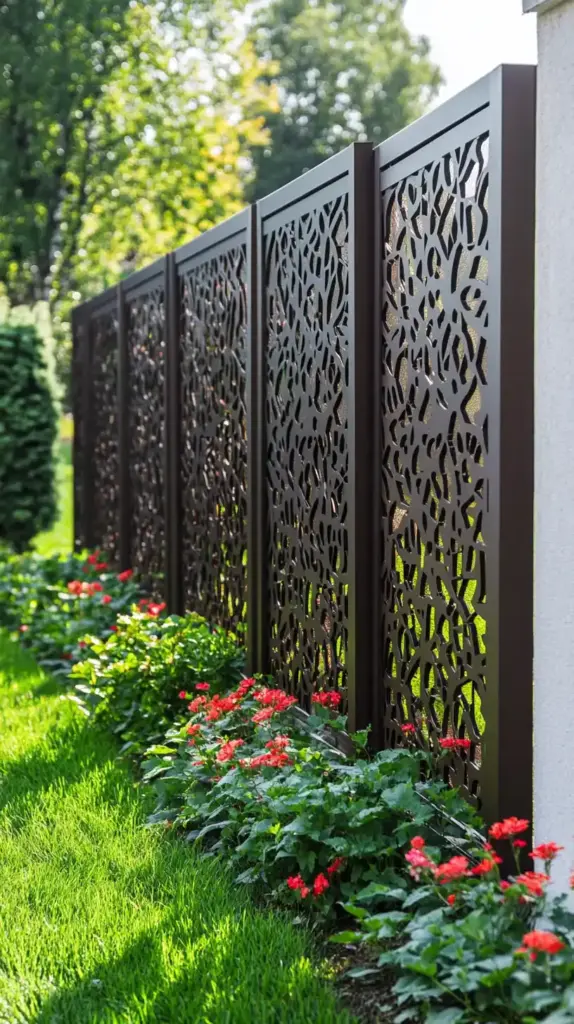
Sometimes, the most powerful garden designs come from simplicity. A modern monochromatic layout transforms your fence line into a structured, high-impact display—proving that bold design doesn’t always require a rainbow of colors. With the right zinnia varieties and layout strategy, your yard can feel like a contemporary botanical gallery.
🎨 Choose a Statement Color
Start by selecting a single color family to anchor your garden’s theme. Deep tones like burgundy, wine, or plum offer drama and elegance. Top choices for this look include:
- Queen Red Lime – Elegant ombré blooms with a touch of green
- Benary’s Giant Wine – Large, velvety petals with rich depth
- Oklahoma Burgundy – Tall and full, with true jewel-toned hues
These varieties vary in height, which helps maintain visual depth while staying true to the monochrome aesthetic.
📐 Plant in Geometric Patterns
Instead of traditional rows or scattered planting, lean into geometric layouts. Use string and stakes to define:
- Rectangles
- Squares
- Clean horizontal bands
Plant tallest zinnias at the back near the fence, tapering forward with shorter varieties. This stepped design mimics modern landscape architecture—layered, symmetrical, and intentional.
🖤 Use Contemporary Garden Accessories
To reinforce the modern vibe of your zinnia fence line garden, add sleek, minimal elements:
- Matte black planters for contrast and form
- Metal garden stakes to support structure
- LED pathway lighting for nighttime ambiance
- Black mulch to create crisp visual separation between plant groups
These simple additions elevate the entire look and emphasize your chosen color palette.
✂️ Keep it Clean with Consistent Maintenance
Monochromatic gardens rely heavily on clean lines and repetition, so staying on top of upkeep is essential. Set a routine to:
- Deadhead every few days to keep blooms tidy and prolific
- Weed and edge frequently for a polished finish
- Wipe down accessories and refresh mulch seasonally
This garden may look minimalist, but the payoff in visual impact is huge—especially when guests do a double take as they stroll past your stunning zinnia fence.
5. Creating the Perfect Cut Flower Garden Station ✂️💐
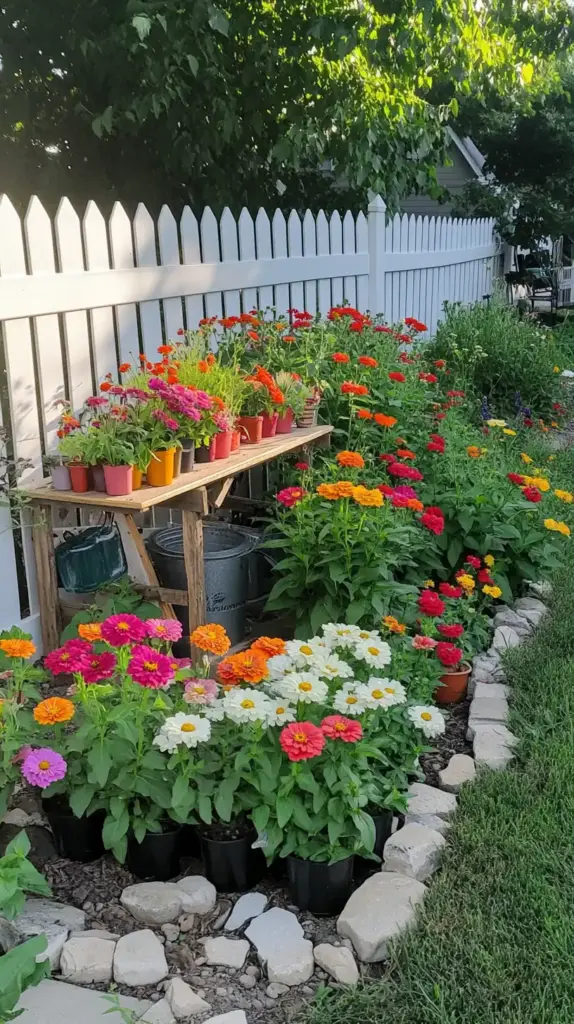
Love the idea of fresh-cut flowers straight from your backyard? With a little planning, your zinnia fence line garden can double as a beautiful and functional cut flower station—perfect for filling your home with vibrant blooms all season long. This section walks you through everything from layout to tools so you can harvest like a pro.
📍 Pick the Right Location
Convenience is everything. Your cut flower station should be close to your zinnia beds and easily accessible from your home. A shady spot along the fence works well—especially in the afternoon when you’re likely to do your harvesting.
Make sure the area has a flat, stable surface. Use materials like:
- Pavers
- Gravel
- Composite decking panels
This keeps your workspace dry and clean, even after watering or summer rains.
🧰 Essential Tools to Keep Handy
A successful cut flower zone needs a few core tools within reach:
- Sharp pruners or scissors
- Buckets of clean water for collecting fresh cuts
- Twine and plant ties
- Spray bottle for misting
- Mini trash bin for clippings
Mount a weatherproof storage box or cabinet to the fence to house your supplies. Add hooks on the outside for frequently used items like gloves or scissors.
🪴 Set Up a Practical Work Surface
Whether you’re arranging stems or measuring cuts, a sturdy worktop helps. A fold-down table attached to the fence is a smart, space-saving option. Upgrade your surface with:
- A non-slip mat for vases and tools
- A mounted ruler or yardstick for stem length
- A shelf for flower food and accessories
This small setup turns your garden chores into a peaceful ritual.
🚶♀️ Plan Accessible Pathways
Don’t overlook your foot traffic! Lay stepping stones or pavers in a pattern that lets you move freely with tools or a cart. Keep paths wide enough to reach every bloom without compacting the soil.
🌸 Plant High-Yield Zinnia Varieties
For a steady stream of flowers, grow zinnias bred for cutting. These include:
- Benary’s Giant – long stems and big blooms
- Queen Red Lime – unique color, perfect for bouquets
- Oklahoma Series – sturdy stems and vibrant hues
- Profusion Series – compact and endlessly productive
Use succession planting (every 2–3 weeks) for non-stop production through the growing season.
6. Vertical Growing System: Maximizing Your Fence Space with Zinnias 🪜🌸
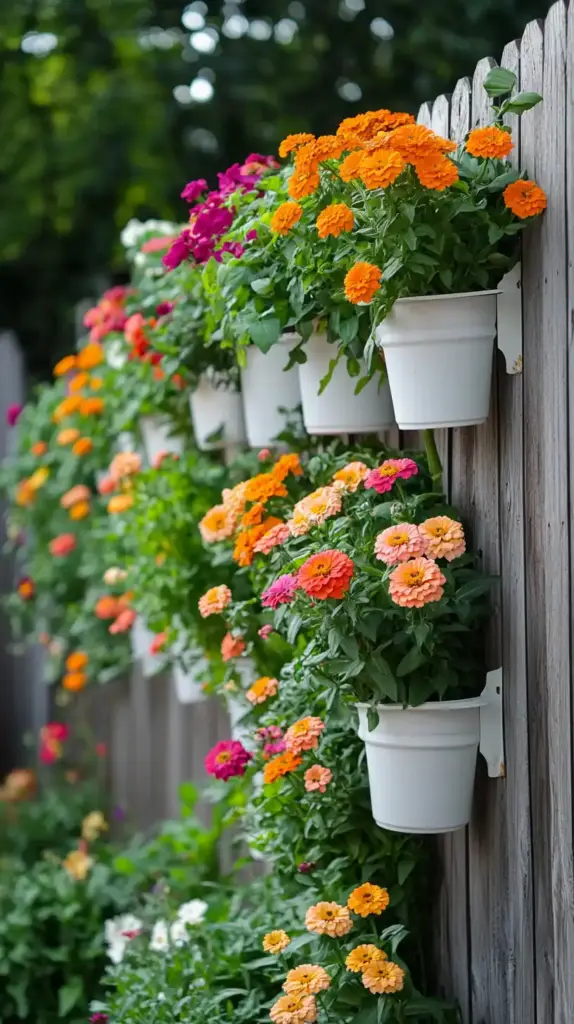
Running low on space but still dreaming of a lush, flower-filled yard? A vertical garden might be the perfect solution. With the right setup, you can turn your fence into a living wall of color using zinnias—making this one of the most practical and visually striking zinnia fence line garden ideas out there.
🪴 Build a Tiered Planter System
To get started, install sturdy tiered planters directly onto your fence. Choose mounting hardware that can handle at least 50 pounds to support wet soil and full-grown plants. Space each planter about 12–15 inches apart vertically to give your zinnias room to stretch.
For best results, plant:
- California Giant zinnias in the top or back tiers for height
- Thumbelina zinnias or dwarf varieties in front for a balanced cascade
🌿 Create a Cascading Living Curtain
Add hanging baskets at varied heights along your fence to create a “living curtain” effect. Use baskets at least 12 inches deep and line them with moisture-retaining material. Fill them with:
- Profusion zinnias for compact, continuous blooms
- Trailing plants like sweet potato vine or creeping jenny for a soft drape
This layered setup brings movement and dimension to your fence garden.
🧱 Add Vertical Support with Trellises
Tall zinnias can sometimes flop under their own weight, so incorporating decorative trellises is a smart move. Install them before planting to avoid damaging roots, and choose designs that match your garden’s style—wood for rustic charm, or metal for a sleek look.
Bonus: Trellises add architectural interest even when plants aren’t in bloom.
🧤 Use Pocket Planters for a Living Wall
One of the easiest ways to extend your planting space is with fabric pocket planters mounted directly onto your fence. These are perfect for:
- Creating texture and depth
- Filling in small or vertical spaces
- Easy watering and maintenance
To keep your pocket garden thriving, install a simple drip irrigation system. It’s low-maintenance and ensures consistent hydration, which is crucial for vertical planting success.
7. Children’s Rainbow Garden 🌈👧🌻

If you’re looking to inspire the next generation of gardeners, there’s no better way than creating a colorful and interactive Children’s Rainbow Garden. This joyful variation of zinnia fence line garden ideas not only beautifies your yard but also engages kids with hands-on learning and discovery. From color games to butterfly spotting, this is a garden built for wonder.
🌸 Choose the Right Zinnias for Kids
Start with zinnias that are bright, sturdy, and easy for little hands to enjoy. Two family-friendly favorites are:
- California Giants – Tall and vibrant, perfect for creating bold color blocks
- Thumbelina Series – Compact and ideal for front borders and small spaces
For maximum impact, plant in color groups of 5–7. Arranging them in rainbow order (red to violet) helps children visualize patterns and practice color recognition while they garden.
🎨 Make It Interactive and Playful
Children thrive on play, so turn your garden into a multi-sensory adventure. Try adding:
- Painted stepping stones decorated by the kids
- Rainbow pinwheels that spin in the breeze
- Weather-resistant plant markers with fun facts
- A watering station with child-sized cans
Create a playful “yellow brick road” effect through the garden with these features to make gardening feel like an imaginative quest.
🧠 Add Educational Touches
Turn your zinnia garden into a vibrant outdoor classroom with these additions:
- Color-matching games using flower shades
- Measuring poles to track zinnia growth
- Lifecycle flashcards mounted on the fence
- Pollinator observation zone with butterfly charts and seating
Kids not only interact with nature but also develop scientific thinking, observation skills, and responsibility.
✅ Keep Maintenance Kid-Friendly
Chores don’t feel like chores when they’re fun! Create a weekly “garden helper” chart with simple tasks such as:
- Counting blooms and insects
- Daily flower check-ins
- Watering duty with colorful cans
- “Flower haircuts” (deadheading)
Involving kids gives them ownership over the garden and builds appreciation for nature’s rhythm and rewards.
This joyful setup not only brings vibrant color to your fence line but also cultivates curiosity, creativity, and connection—all through the simple magic of zinnias.
8. Creating a Drought-Resistant Zinnia Border 💧🌞
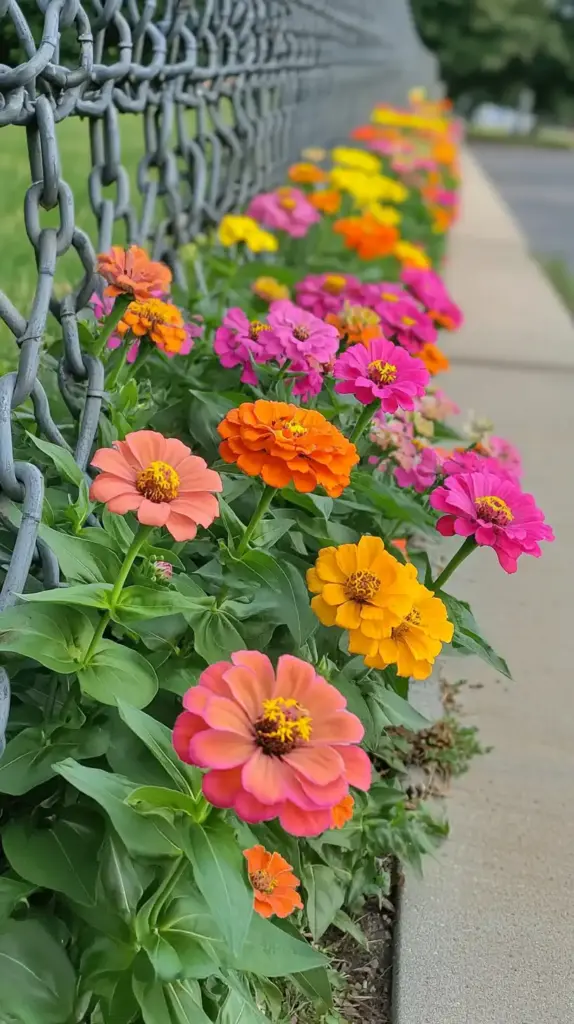
Water-wise gardening is more important than ever—and the good news is that zinnias are naturally resilient. With a few smart choices, you can create a stunning, low-maintenance zinnia fence line garden that thrives even during the driest summer months. This border style is ideal for hot climates, busy gardeners, or anyone looking to conserve water without sacrificing beauty.
🌼 Choose the Right Varieties for Dry Conditions
When planning a drought-tolerant zinnia garden, start by selecting varieties bred for heat and minimal water use. Top picks include:
- Oklahoma Series – Compact, tough, and continuous bloomers
- Profusion Series – Award-winning and perfect for dry borders
- Desert Series – Specifically developed for arid climates
These zinnias have smaller blooms and dense foliage, which helps retain moisture and requires less irrigation overall.
🌿 Companion Planting with Native Toughies
To strengthen your drought-resistant border, combine zinnias with native or low-water plants. These companions add texture, color, and resilience:
- Lantana – A tough little burst of color that thrives in heat
- Salvia – Vertical blooms that attract pollinators
- Verbena – Great for ground cover and soil moisture retention
- Russian Sage – Airy and architectural, perfect for backdrops
This mix supports biodiversity and helps your zinnias thrive by reducing evaporation and improving soil health.
💧 Smarter, Not More, Irrigation
Watering less often—but more strategically—is the key. Install a drip irrigation system to deliver water directly to plant roots with minimal waste. You’ll reduce water use by up to 40% while keeping your flowers healthy.
A drip line or soaker hose along the fence ensures deep, consistent moisture without promoting fungal issues.
🍂 Mulching for Moisture Retention
Mulch is your drought garden’s best friend. A 3-inch layer of organic mulch:
- Retains soil moisture
- Regulates soil temperature
- Suppresses weeds
Top mulch picks:
- Pine straw
- Shredded bark
- Cocoa hulls (they even add a sweet scent!)
- Composted leaves
Just be sure to leave a small gap around plant stems to prevent rot.
With the right setup, your zinnia fence line garden can flourish with just one or two deep waterings a week—even during peak summer heat. It’s eco-friendly, budget-conscious, and still absolutely beautiful.
9. Creating the Perfect Photography Corner with Zinnias 📸🌸
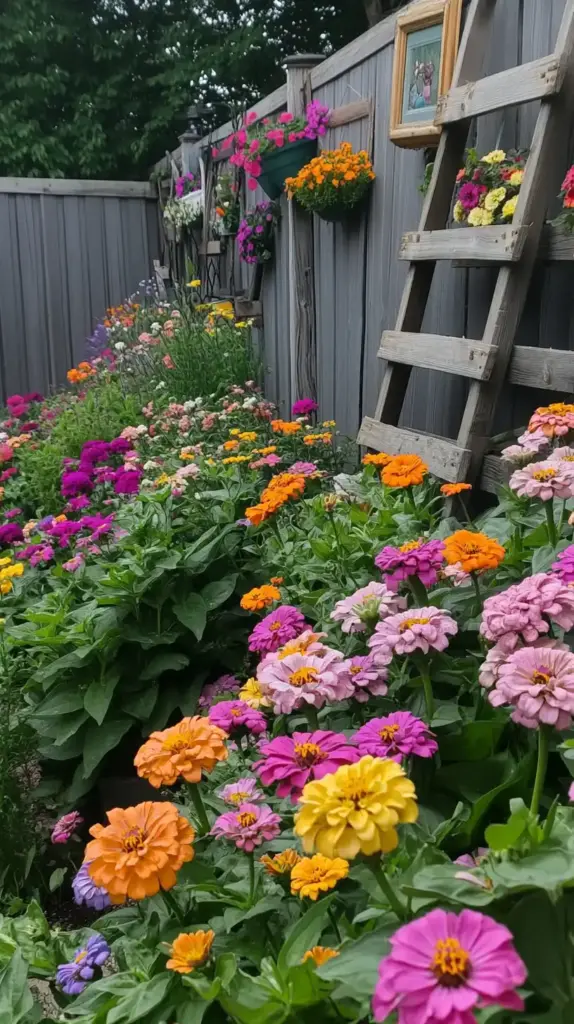
Your garden isn’t just a place to grow flowers—it can also be your very own outdoor photo studio. If you love sharing blooms on social media or just want a beautiful backdrop for family photos, this zinnia fence line garden idea is all about designing a space that looks as good in pictures as it does in person.
🎨 Design a Picture-Perfect Background
A flawless photo starts with a clean, intentional backdrop. Skip the clutter and aim for a solid-colored fence painted in a neutral hue like soft gray, white, or even matte black. These tones let your zinnias shine while minimizing distractions.
Enhance visual interest by adding:
- Vintage garden tools mounted on the fence
- Rustic wooden frames for a DIY garden gallery feel
- Trellises or lattice panels for texture and climbing plants
These accents provide framing for your flower shots and help build a charming atmosphere.
⛰️ Use the Triangle Planting Technique
To create stunning visual layers, plant zinnias in a triangle layout:
- Tall varieties (like Giant Lime or Oklahoma Pink) at the back
- Medium-height zinnias in the center
- Compact types (like Thumbelina) in front
This tiered effect adds depth and naturally draws the eye. For a color pop, pair complementary shades like:
- Coral + lime
- Purple + yellow
- Pink + orange
Your zinnias become a painter’s palette right outside your door.
🌟 Add Character with Decorative Touches
The small details make the biggest visual impact. Scatter charming props that double as decor and storytelling tools:
- Vintage watering cans nestled among the blooms
- Solar lanterns for magical dusk photos
- Wooden quote signs with garden sayings
- A trellis or archway to frame photos naturally
These elements bring warmth and authenticity to every shot.
🪑 Focus on Focal Points
Create Instagram-worthy “moments” by building intentional focal points. Try:
- Monochrome zinnia clusters in bold colors
- Decorative pots or planters placed at key angles
- Garden benches or small seating nooks for portraits
- Butterfly stations with pink and orange blooms to attract pollinators mid-photo
Leave a little breathing room between focal zones. Negative space keeps photos from feeling too busy and helps the flowers really stand out.
10. Creating a Wildlife-Friendly Zinnia Border: A Haven for Local Fauna 🐝🦋🕊️
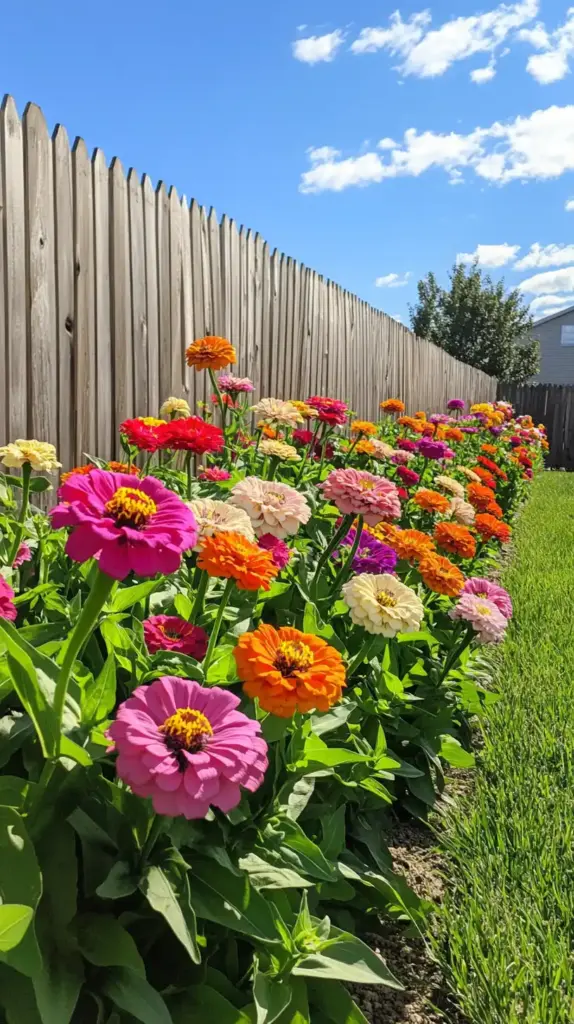
If you’re looking to turn your garden into more than just a beautiful backdrop, a wildlife-friendly zinnia border might be your perfect project. This approach transforms a traditional zinnia fence line garden into a thriving mini-ecosystem that attracts pollinators, birds, and beneficial insects—bringing your yard to life in the most natural way possible.
🌼 Start with Wildlife-Loving Plant Combos
To make your garden irresistible to local fauna, combine zinnias with native flowers that support local pollinators. Some proven plant partners include:
- Black-eyed Susans – Excellent nectar source and hardy
- Purple Coneflowers – Loved by bees and butterflies
- California Giant Zinnias – Bright and long-lasting blooms
Plant in clusters of at least five to create bold, visible targets for flying insects. These “landing pads” help pollinators spot feeding zones from above and increase activity in your garden.
🚿 Add Simple, Effective Water Features
You don’t need a full pond to attract birds and butterflies. A ceramic birdbath with a solar-powered bubbler works wonders. Place it about 3–4 feet from dense plants to give birds easy flight access while keeping nearby cover for safety.
This small addition brings constant movement and music to your zinnia border.
🪵 Create Microhabitats for Beneficial Insects
Healthy gardens rely on unseen allies like native bees, ladybugs, and predatory beetles. Encourage them by adding:
- Stacks of stones with air pockets
- Hollow stem bundles from previous-season cuttings
- Brush piles tucked behind tall zinnias
- Native bunch grasses for shelter and breeding zones
These small habitats help balance your garden’s ecosystem and promote natural pest control.
🌱 Maintain with a Light Touch
Wildlife-friendly gardens thrive on low intervention. Skip chemical pesticides, allow some seed heads to remain through fall, and leave a few dried stems over winter for insect shelter. Birds like goldfinches love zinnia seeds and will reward your patience with aerial shows.
Tip: Deadhead selectively—leave about 25% of your blooms to go to seed for birds while keeping the rest fresh for pollinators.
🌿 Frequently Asked Questions: Zinnia Fence Line Garden Ideas
❓Can zinnias grow well along a fence?
Absolutely! Zinnias thrive along fences because they love full sun and benefit from the wind protection a fence provides. Plus, the vertical backdrop highlights their vibrant blooms beautifully—making fence borders one of the best zinnia garden ideas.
❓What are the best zinnia varieties for fence planting?
For tall fences, go with California Giants or the Benary’s Giant Series, which reach up to 4 feet. For layered looks, use Oklahoma Series in the middle and compact Thumbelina zinnias in the front. These combinations work especially well in zinnia fence line garden designs.
❓How do I keep zinnias blooming all season?
Deadhead regularly (removing spent blooms) to encourage new flowers. Zinnias also appreciate deep but infrequent watering and benefit from monthly feeding with a balanced fertilizer.
❓Can zinnias attract pollinators?
Yes! Zinnias are favorites of butterflies, bees, and even hummingbirds. Planting them in clusters along your fence makes them highly visible to pollinators and turns your garden into a buzzing, fluttering ecosystem.
❓Do zinnias need support or staking along the fence?
Tall zinnia varieties may need gentle staking, especially in windy areas. Planting them next to a fence makes it easier to provide support using simple garden ties or trellises.
❓Can I grow zinnias in poor or dry soil?
Zinnias are surprisingly tolerant of lean soil, especially drought-resistant varieties like the Profusion or Desert Series. However, amending your soil with compost and adding mulch will boost performance and reduce watering needs.
🌼 Conclusion: Let Your Fence Bloom with Personality
Your fence line doesn’t have to be a blank space—it can be a vibrant canvas bursting with creativity, color, and life. With these 10 inspiring zinnia fence line garden ideas, you now have the tools to design a space that reflects your personality, supports pollinators, and brings joy season after season.
Whether you’re aiming for a drought-tolerant garden, a child-friendly rainbow path, or a vertical flower wall that turns heads, zinnias offer unmatched versatility. Pair them with ideas from our DIY trellis guide or explore companion blooms in our cut flower garden ideas to take your border to the next level.
🌿 So go ahead—pick your favorite idea (or mix a few!), dig in the dirt, and let your fence line come alive with blooming beauty.


